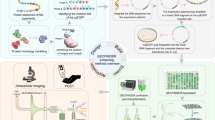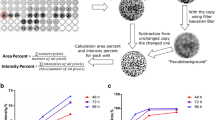Abstract
A new method to screen antibiotic combinations is demonstrated, which takes advantage of the logic-signal output of genetically engineered drug-resistant E. coli strains expressing different fluorescent proteins. Thirty-six antibiotic combinations for nine antibiotics were investigated. The operation of different logic gates can reveal the susceptibility, resistance, or synergistic effect of the antibiotic combinations in a rapid (7–8 h versus 24–28 h for typical growth-based assays), simple, quantitative and high-throughput manner. This logic-signal-based output patterns provide the basis for novel and reliable screening of antibiotic combinations and help us to both gain insight into the mechanisms of multi-drug action.
Similar content being viewed by others
References
Fisher JF, Meroueh SO, Mobashery S. Bacterial resistance to beta-lactam antibiotics: compelling opportunism, compelling opportunity. Chem Rev, 2005, 105: 395–424
Levy SB, Marshall B. Antibacterial resistance worldwide: causes, challenges and responses. Nat Med, 2004, 10: S122–S129
Smith PA, Romesberg FE. Combating bacteria and drug resistance by inhibiting mechanisms of persistence and adaptation. Nat Chem Biol, 2007, 3: 549–556
Kohanski MA, Dwyer DJ, Collins JJ. How antibiotics kill bacteria: from targets to networks. Nat Rev Microbiol, 2010, 8: 423–435
Pope AJ, Haupts UM, Moore KJ. Homogenous fluorescence readouts for miniaturized high-throughput screening: theory and practice. Drug Discovery Today, 1999, 4: 350–362
Zhu CL, Yang Q, Liu LL, Wang S. Rapid, simple, and high-throughput antimicrobial susceptibility testing and antibiotics screening. Angew Chem Int Ed, 2011, 50: 9607–9610
Bunz UHF, Rotello VM. Gold nanoparticle-fluorophore complexes: sensitive and discerning “Noses” for biosystems sensing. Angew Chem Int Ed, 2010, 49: 3268–3279
Shaner NC, Steinbach PA, Tsien RY. A guide to choosing fluorescent proteins. Nat Methods, 2005, 2: 905–909
Palacios MA, Benito-Peña E, Manesse M, Mazzeo AD, Lafratta CN, Whitesides GM, Walt DR. InfoBiology by printed arrays of micro-organism colonies for timed and on-demand release of messages. Proc Natl Acad Sci, 2011, 108: 16510–16514
Margulies D, Melman G, Felder CE, Arad-Yellin R, Shanzer A. Chemical input multiplicity facilitates arithmetical processing. J Am Chem Soc, 2004, 126: 15400–15401
de Silva AP, McClenaghan ND. Molecular-scale logic gates. Chem Eur J, 2004, 10: 574–586
Balzani V, Venturi M, Credi A. Molecular Devices and Machines. A Journey into the Nanoworld. Weinheim: Wiley-VCH, 2003
Kou SZ, Lee HN, van Noort D, Swamy KMK, Kim SH, Soh JH, Lee KM, Nam SW, Yoon JY, Park SS. Fluorescent molecular logic gates using microfluidic devices. Angew Chem Int Ed, 2008, 47: 872–876
Feng XL, Duan XR, Liu LL, Feng FD, Wang S, Li YL, Zhu DB. Fluorescence logic-signal-based multiplex detection of nucleases with the assembly of a cationic conjugated polymer and branched DNA. Angew Chem Int Ed, 2009, 48: 5316–5321
Tang YL, He F, Wang S, Li YL, Zhu DB, Bazan GC. Multiply configurable optical-logic systems based on cationic conjugated polymer/DNA assemblies. Adv Mater, 2006, 18: 2105–2110
Ausländer S, Ausländer D, Müller M, Wieland M, Fussenegger M. Programmable single-cell mammalian biocomputers. Nature, 2012, 487: 123–127
Author information
Authors and Affiliations
Corresponding authors
Electronic supplementary material
Rights and permissions
About this article
Cite this article
Lv, F., Liu, L. & Wang, S. Logic-signal output of fluorescent proteins for screening antibiotic combinations. Sci. China Chem. 57, 1696–1702 (2014). https://doi.org/10.1007/s11426-014-5224-6
Received:
Accepted:
Published:
Issue Date:
DOI: https://doi.org/10.1007/s11426-014-5224-6




